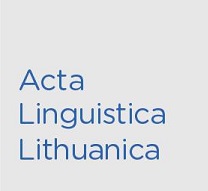Vainiklapių spalvos ir atspalviai šiuolaikinėje lietuvių prozoje: balta ir juoda
Colours and Shades of Petals in Modern Lithuanian Prose: Black and White
Author(s): Aurelija GritėnienėSubject(s): Fine Arts / Performing Arts, Studies of Literature, Semantics, Lithuanian Literature
Published by: Lietuvių Kalbos Institutas
Keywords: semantics; colocation; color; white; black; artistic style;
Summary/Abstract: The article analyses more than 300 collocations found in 98 works of 61 modern Lithuanian prose authors, these collocations are used by the authors to convey the white or black colour of the petals of flowering plants and the shades of these colours. Analysed prose authors in their texts mention approximately 70 white flowering plants, these are: trees, bushes, fruit trees, berry scrubs, weeds, forest, meadow, field, garden, indoor and other plants. In the analysed collocations only 4 black flowering plants (lilies, roses, tulips and greater celandines) are found. Research material indicates that when conveying the colour of achromatic petals authors usually use the adjectives white (Lith. baltas, -a; juodas, -a; feminine and masculine form; 152 collocations) and black (Lith. juodas, -a; feminine and masculine form; 10 collocations). Less frequently the colour of petals is described by using pronominal form of adjectives (the white (Lith. baltasis, -oji; feminine, masculine form) used 41 times; the black (Lith. juodasis, -oji; feminine, masculine form) used 9 times). Usage of the pronominal form of adjectives is determined by the context of the story: the white usually marks the sorts of plants that really exist (e.g. the white clover, the white lily; Lith. baltasis dobilas, baltoji lelija, etc.) and the black is usually used when imaginary sorts or kinds of plants are described in the work. The highest intensity of white colour is emphasized by using the superlative form of adjectives, i.e., the whitest (Lith. balčiausias, baltų balčiausias), tautological collocations white white (Lith. baltas baltas), derivatives formed with suffixes snow-white (Lith. baltutėlis), etc. Verbs showing white, was showing white, shine white, shone white, will shine white (Lith. baltuoja, baltavo, boluoja, (su)bolavo, suboluos) are used to indicate white colour in prose works as well. Some authors use adverb whitely (Lith. baltai) to indicate the colour of petals in their texts. To indicate this colour the prose writers also use nominal abstracts whiteness (Lith. baltumas, baltuma, baltybė). There are cases when achromatic colours are conveyed through a concrete object, a certain colour prototype. The colour white and its shades quite frequently are described by using various comparisons. Usually, plants that have white petals are compared to the closest objects of the person’s surroundings: snow, soap suds or milk foam, cotton, wedding dress, shroud, some food items, white birds. It can be said that comparisons as these have become stereotypes: white as snow/paper/milk/foam/curd/swan); black as night. Analogous prototypically white reality denotates (pale face, feet, hands, fingers, teeth, breasts, white hair, swans, paper, snow, etc.) are compared to white petals of plants. It was noticed that female authors more thoroughly and more creatively convey to the readers colours and shades of the blooms. Male authors usually indicate the precise colour of the bloom but rarely mention subtle shades of colour of the blooms. More poetically and in detail male authors describe only more well-known white flowering booms (apple tree, cherry three, lily, etc.). These differences are determined not only by the specificity of gender but also by individual qualities of the writer. Analysed collocations show that the authors use more varied literary devices to describe naturally growing and blooming plants (cherry trees, apple trees, mock-oranges, etc.). The colour of picked flowers is usually indicated in a very specific way, i.e., by using adjectives white and black.
Journal: Acta Linguistica Lithuanica
- Issue Year: 2017
- Issue No: 76
- Page Range: 134-154
- Page Count: 21
- Language: Lithuanian

